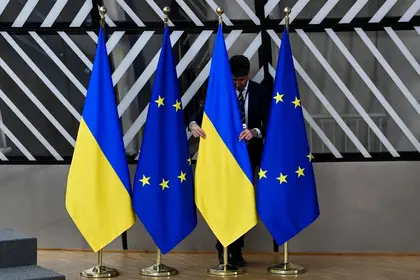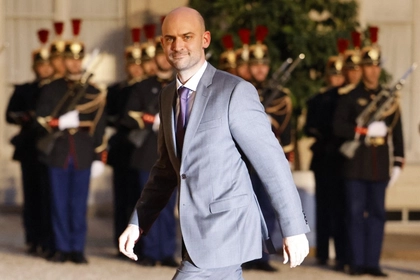Apart from military action, the recent EU-Ukraine summit has become the main event of February and perhaps the whole winter. Ukraine’s ongoing European integration is key not only ideologically, but also the economically.
The country’s postwar recovery will be closely tied to European integration. Its investment attractiveness is currently based on its future EU membership. It does not matter whether this is achieved in two years, as Prime Minister Denys Shmyhal predicts, or in 5 to 10 years. The main thing is the inevitability of this process, because investors tend to invest with a perspective of 10 to 20 years.
JOIN US ON TELEGRAM
Follow our coverage of the war on the @Kyivpost_official.
That is why what happened before, after and during the summit is so important. Let’s go in reverse order and focus first on the conclusions. What was the summit like? It was quite successful not only because Putin, despite all his verbal threats, did not dare to shell Kyiv while the European commissioners were staying there, but also because Ukraine seems to be maintaining a high pace of European integration, despite all the problems.
What does this indicate? Let’s listen to the bureaucratic language. The following was said in the final documents:
“The EU reiterated that the Commission has been invited to report on the fulfilment of the conditions specified in the Commission’s opinion on Ukraine’s membership application as part of its regular enlargement package in 2023. Without prejudice to this comprehensive regular reporting, we take note of the Commission’s intention to provide an update in spring 2023 which will also be conveyed to Ukraine through the appropriate channels.”
![[VIDEOS] North Korean Troops in Russia Confirmed](https://static.kyivpost.com/storage/2024/10/19/a6f6a4c5d74d066019e5812a20c6514f.png?w=420&q=75&f=webp)
[VIDEOS] North Korean Troops in Russia Confirmed
According to experts, this phrase is the main victory for Ukraine in terms of advancing towards EU membership. These are the words that allow us (of course, if Kyiv implements the reforms!) to start the EU accession negotiations as early as 2023. So far, the EU has refused to provide Ukraine with a written assessment of what remains to be done to fulfill the already mentioned seven criteria earlier than in October 2023. Now it has agreed to hand it over in writing, depending on the context, in the spring.
This will make it possible to “work on mistakes” and in the best-case scenario, perhaps, even receive an EU decision on the start of accession negotiations in the autumn. The main requirement is the full and sincere implementation of the reforms. It is important to remember that, as they say, Ukraine has never missed its chance to miss a chance until recently.
Now we are approaching a situation that existed before the summit: namely, there have been a whole series of publications in the Western media arguing that Ukraine is rushing and it is necessary to slow down. Why? What is hampering the process?
As always, there are two key issues – internal Ukrainian history and external history. As for the internal one: there are problems with corruption and the rule of law that have hindered investors in Ukraine for decades – what they themselves have pointed to as a deterrent to investment. There is some progress in the reforms but it is very weak. Sometimes it looks like simulation. Of course, the public “flogging” of corrupt officials two days before the summit could not but elicit approval and positive comments from EU representatives, but it did not mislead anyone. So far, the political will for real reforms in this area is not visible and that will be a problem. The opponents of Ukraine’s European integration will take advantage of this – the Russians above all, but not only them.
Recently, the second, external element forestalling Ukraine’s European integration has been clearly defined. The matter concerns European agrarian lobbyists who felt the “breath” of the agrarian superpower in 2022 when Ukrainian goods, primarily agricultural products, gained access to the EU market and began to conquer it, despite the problems with exports because of closed ports.
European producers were startled by the flow of Ukrainian poultry, eggs, grain, and other products. In Europe, the agricultural industry is very often a kind of social sector, while in Ukraine – it’s a business, an effective business, which, of course, could be much more profitable if there were no superstitions, such as the opposition to GMOs or the prohibition of medical cannabis. However, even the existing efficiency of Ukrainian agricultural companies has been enough to scare producers and recipients of subsidies.
The recipients of subsidies, calculated based on the area of agricultural lands, were frightened by Ukrainian agrarian areas. No one wants to share his own money, especially big money.
Therefore, Ukraine must be ready for such opposition.
Is it fair? Of course, not. Brazilian chicken has a much larger share of the EU market than Ukrainian chicken. But it is sold there, and lobbyists can’t do anything about it. Whereas there is still a chance with Ukrainian poultry.
As such, there will be opposition – public and non-public.
Does this mean that we have faced an insurmountable obstacle? No. However, this is definitely something we need to take into account. We should be prepared to speed up the membership process because it will accelerate cash flow into Ukraine.
You can also highlight the text and press Ctrl + Enter






